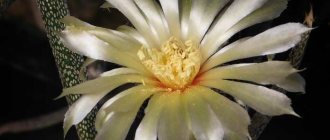Growing cacti from seeds is a complex but very exciting process. Growing cacti from seeds, we observe the entire development process from seed to adult state of these absolutely amazing plants. In this way, you can grow rare species of cacti and succulents that are rarely on sale. And most importantly, cacti grown from seeds will not need acclimatization. But this requires time and patience.
Mammillaria
A very popular and widespread type of cactus, which is often found in home collections. There are several varieties of it - small and medium in size, with a cylindrical and spherical trunk, with different spines, with and without pubescence. Plants are unpretentious in care. It is very important for them to find a well-lit place, water regularly but moderately and prevent pests.
With proper care, the cactus blooms in the warm season. Small flowers (no more than 2 mm) from white to bright pink appear on the trunks. Some species (Mamillaria saboae, Mamillaria de-herdtiana, etc.) have larger flowers.
Boarding procedure
How to sow correctly?
- A layer of drainage (1-2 cm) is poured into the disinfected container, then the prepared substrate (3-4 cm). 1/3 of the container should be empty.
- The earth is watered with warm boiled water.
- Using a toothpick, holes are made at a distance of 1 cm into which the disinfected seeds are planted.
- The soil with seeds is sprayed with water from a spray bottle, but not watered.
- The greenhouse is covered with a lid and placed in a sunny place.
Attention! Seeds are germinated on the surface of the soil and not covered with soil.
Below is a visual video with the procedure for planting cactus seeds:
Cacti can be propagated not only by seed, but also by children. Also, when growing thorny plants, it is important to know about grafting and planting without roots.
Queen of the Night (Selenicereus grandiflorus)
This truly unique cactus, which has almost smooth shoots, did not get its beautiful name by chance. The exquisite and sophisticated beauty of cactus blossoms and the pleasant strong aroma of flowers force gardeners to choose this particular plant for their collection. And, despite the fact that the huge flowers (more than 30 cm in diameter) bloom only for one night, and placing this cactus with shoots that reach several meters in length is quite problematic, Selenicereus deserves the effort spent so that it can be admire the spectacular blooms.
Euphorbia (Euphorbia)
A well-known plant among cacti lovers, it got its name because of the viscous viscous liquid released when the stems and leaves are broken. Do not try to taste this liquid - it is poisonous. In ancient times, arrowheads were moistened with milkweed juice. The stems of milkweed are triangular in shape, covered with thorns, and quite tall. It is not difficult to keep this cactus at home, but it is important to ensure that the plant is inaccessible to children.
Shlumbergera, or Decembrist
This cactus was first discovered in the forests of Brazil, where it was called Schlumbergera or zygocactus. However, in our country he is better known as the Decembrist. This species is popular and widespread due to the beautiful flowers that bloom in December.
The cactus has a rather unusual spreading shape. It can grow up to 1.5 meters wide. Unlike most members of the Cactus family, this plant does not have thorns and loves frequent and abundant watering, and does not tolerate direct sunlight.
Varieties of cactus - which varieties are best to plant?
Cacti are divided into desert and forest. Both varieties love the sun and hate the shade. Several varieties of prickly plants are suitable for self-cultivation:
- Echinopsis is a flowering plant in the shape of a ball, which can be grown using cuttings;
- Céreus is a giant with multi-colored spines, propagated by seeds and cuttings, does not bloom;
- Opuntia is a flat version of the cactus that can be grown by cuttings;
- Mammillaria is a spherical green friend that throws out bells during flowering, can be small or large, and reproduces with the help of shoots and seeds.
Before choosing a variety, you need to decide on the plant size, shape, color and growing method. An unpretentious culture at first glance, like others, requires care.
Reproduction
This method is most often used in breeding work, because cacti also reproduce well vegetatively. But sometimes propagation of cacti by seeds is also used in indoor floriculture, for example, when it is not possible to purchase a grown plant of a certain variety. You need to prepare everything you need to grow these thorny plants and be patient. The fact is that plants grown from seeds can bloom for the first time no earlier than five years after sowing.
Advantages and disadvantages of the method
Advantages:
- the rarest types of cacti reproduce only by sowing (they do not produce children or shoots);
- the plant is more resilient;
- low cost of seed.
Flaws:
- the complexity of the preparatory process;
- some seeds (for example, Parody) are very small;
- low percentage of germination and survival of seed (50%);
- constant supervision and care of seedlings is required;
- the occurrence of difficulties during the period of initial growth: decay; sprouting sideways or roots up; shell sticking; “blooming” of the earth and others.
More information about the propagation of cacti can be found here.
cactus seeds
These exotic plants are becoming increasingly popular in our country. However, even many experienced gardeners do not always know what cactus seeds look like, since these plants are often propagated vegetatively. Today you can purchase a wide variety of seeds of these plants in specialized stores. Anyone interested in how to grow a cactus from seeds should know that the process is long, but extremely interesting. Beginners in indoor floriculture usually choose seeds of columnar, fast-growing cacti that bloom after a few years, for example, rebutias or a mix of seeds of different varieties.
It is necessary to know well the types of home cacti and what the seed should look like so as not to avoid disappointment in the future. Often, flower growers who use seeds for propagation for the first time fail to achieve the desired result. In the photo below and further in the article, you can see what cactus seeds look like.
You can collect seeds from plants in your collection. For cross-pollination, you need to have two cacti that were grown from seeds or cuttings of different plants. The flowers from which you plan to take pollen must be fully open so that the pollen can be easily separated and can be collected on a brush. Pollen from one flowering plant is transferred to the flower of another. After some time, a berry appears in place of the flower.
To propagate a cactus by seeds, you must use a fully ripened berry. You should break it very carefully and remove the seeds. They can be stored for two years in a paper bag, signed with the name of the variety and the date of collection of the seeds.
Where to buy material for sowing and what does it look like in the photo?
Seed material can be purchased at the store or collected seeds yourself. The first option is suitable for beginner gardeners, the second - for experienced gardeners who have at least two unrelated plants of the same variety. Their flowers must be cross-pollinated and wait for the berries to ripen. When the berries ripen, the seeds are dried and prepared for planting.
Due to the small size of the seeds, it is difficult to determine whether they are healthy or not by appearance. The main criterion is the freshness of the seeds; they should not be stored for more than six months. If the seeds were stored in a damp place or the packaging shows signs of wetness, such specimens are not suitable for planting.
How to germinate cactus seeds?
If you want to grow this amazing plant from seeds, make sure that the variety or species you choose is not subject to genetic mutations and retains all varietal characteristics. Before sowing cacti with seeds, you should learn about the basic rules.
The seeds of these plants germinate slowly. The seedlings also develop slowly. Despite the fact that seeds require heat and moisture for germination, it should be borne in mind that seedlings of these plants are very susceptible to various fungal diseases. It is for this reason that when sowing it is necessary to maintain a certain temperature and humidity, trying to prevent the development of fungal diseases.
The seeds should be soaked for a day. For this, a weak solution of potassium permanganate is most often used. It is not recommended to use growth stimulants for this purpose - their effect on cacti has not yet been fully studied.
Seed packets should be opened over a sheet of paper. Cactus seeds are so small that they look more like dust. Therefore, such precaution will help preserve the seed material. Soaking will not only awaken the seeds, but also remove any remaining pulp. This significantly reduces the risk of mold formation in the soil and provides a healthy environment for growing cacti from seeds.
In order for the seeds to germinate, it is necessary to maintain the air temperature during the day within the range of +26 to +30 ° C, and at night reduce it by ten degrees.
Preparing containers and soil
It is better to plant seeds in a shallow plastic container, the height of which does not exceed 8 cm. The bottom of the cup must have perforation to ensure the free flow of excess liquid. As for the color of the pots, the best option would be white matte containers that are not prone to absorbing sunlight and protect young shoots from overheating. In addition, the cups should have transparent lids that will cover the planted seeds. It is recommended to sow each species separately and mark it with a number or name.
Immediately before sowing, the sowing dishes must be thoroughly washed and disinfected using a strong solution of potassium permanganate or formaldehyde. Ceramic containers can be boiled - this helps get rid of pathogenic microflora and prevent infection of plants.
Cacti grow well in poor soils. Therefore, for sowing, we recommend choosing a special substrate that will have a slightly acidic pH-6 reaction and good water and air permeability. Experts advise making a mixture of coarse sand and leaf soil in equal parts and adding a small amount of charcoal and peat to it. Before adding seeds to the soil, it must be thoroughly disinfected.
Soil and dishes
Cactus seeds can be sown in wide, low containers, for example, made of styrofoam, which are first washed with very hot water, but not with boiling water. A clay convex shard is placed on the drainage hole in the bottom of the container. A drainage layer of expanded clay or small pebbles is poured onto the bottom, which is first spilled with boiling water.
The container for germinating seeds is filled 2/3 full with loose soil mixture for cacti. It should contain a large amount of perlite or coarse sand. Many experienced gardeners believe that the soil should be baked in an oven or microwave. In other words, disinfected to provide maximum protection against fungal diseases.
On top of the soil mixture is covered with a layer of crushed basalt, broken brick or sand (coarse-grained) about a centimeter. The material is first sifted, bringing the grain size to 2 mm. After this, they are washed to remove small particles, dried and scattered over the surface of the soil. This layer will not become a breeding ground for pathogens of various diseases.
Sowing
Sowing cacti with seeds is carried out evenly over the entire surface of the previously prepared container. To do this, you need to fold a piece of paper in half, pour the seeds into the resulting groove, then, lightly tapping the paper slightly inclined towards the soil, pour the seeds evenly onto the soil surface.
Due to the fact that cacti grow slowly and develop more actively in the community, the seeds are sown quite densely. After sowing, they are lightly pressed into the soil using any object with a smooth surface, for example a matchbox. Since seeds need light to germinate, they are not sprinkled with soil on top. The soil is not watered, but sprayed with a spray bottle.
The container is covered with glass and placed in a place with artificial heating. It is necessary that the earth warms up to +30 °C during the day and to +20 °C at night. Seedlings in a container are placed on a central heating radiator (in winter) or on a heating pad.
Emergence of seedlings
The duration of illumination of crops should be at least 12 hours a day, which is provided by natural sunlight (spring) or fluorescent lamps (up to 5000 lux in autumn and winter).
A couple of weeks after sowing the cacti, seed germination will become clearly visible, and with the appearance of the first spines, the plants will need to be ventilated daily. Every day, open the container 1-2 times for ventilation and wipe the lid from the inside to prevent moisture from flowing back.
To avoid the appearance of fungus, many breeders recommend using a 0.5% Quinozol solution at this stage, diluting one tablet of the drug in 2 liters of water.
Picking
When the seedlings in the container begin to create a clump (dense cushion), they should be planted in fresh soil. At the same time, the soil mixture in the planting tray must be dry - in this case, it easily disintegrates and it will not be difficult to remove the seedlings without damage. Young cacti grown from seeds, which by this time have reached up to a centimeter in diameter, are planted in larger containers, several at a time.
After transplantation, seedlings are kept in a shaded, warm place. A few days after transplantation, carefully water the cacti. How often should this be done during this period? Experienced gardeners believe that the soil must be moistened as it dries.
After about a week, when the seedlings adapt to fresh soil, they are transferred to a slightly shaded but bright place. Plants begin to grow and develop a little faster.
Crop care
It is important not only to know how to grow a cactus, how to prepare and sow the seeds. It is necessary to understand what kind of care seedlings require. First of all, you should properly organize the watering of cacti. How often and how to carry out this procedure so as not to harm young plants? Sometimes in special publications you can find recommendations from flower growers about immersing containers with seedlings in water to moisten the soil. But this old method was used before the advent of fine sprays. Now they are used to water the soil once a day.
What to do if they don’t take root?
If the cacti do not take root, you need to reconsider the conditions of their maintenance and check for the presence of diseases. If infected specimens are found, they must be immediately separated from healthy ones and destroyed. The remaining sprouts should be treated with a solution of potassium permanganate . At the initial stage, you can resort to an emergency change of environment and force the cactus to go into hibernation by lowering the temperature and reducing watering. Then you can replant the plant and resume the care cycle.
Growing a cactus is not easy, but it is incredibly interesting. The plant that survives the initial growth stage will be strong and hardened. When you grow seeds yourself, you can get unexpected results in the form of new specimens of hybrid varieties.











